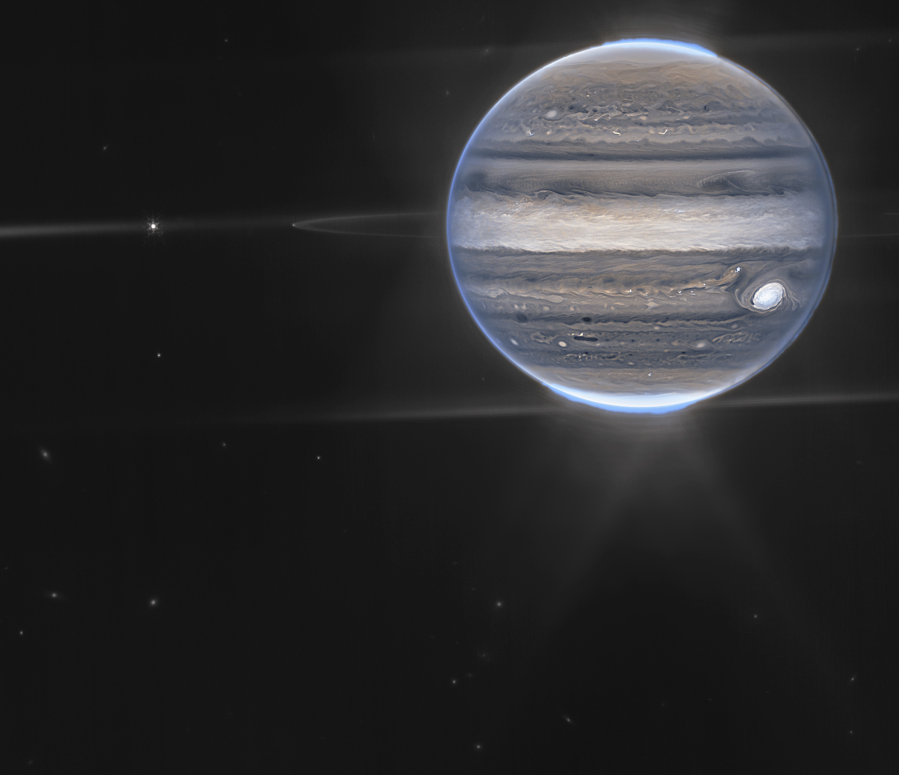“There, by one of Nature’s supreme jests, was something very precious to mankind,” Clarke writes. “The core of Jupiter, forever beyond human reach, was a diamond as big as the Earth.”
We have fallen behind Clarke’s schedule, in that it’s now 12 years later than he imagined, yet we still haven’t visited the center of Jupiter. This fall, however, all you have to do is look up at night to catch Jupiter gleaming like a heavenly diamond.
By far the largest of all the planets in our solar system, Jupiter has already been big and bright in the night sky for months this year, but its rising hour has been inconveniently late for those of us who aren’t owls. But the planet’s nightly appearance has also been backing up through evening hours, and it’s now entered the zone of easy visibility for stargazers who still seek a reasonable bedtime.
Jupiter rises at 7:21 p.m. today, almost directly to the east, and spends most of the night crossing the southern sky — at a maximum elevation of about 44 degrees — before setting almost exactly 12 hours later.
Sizing up Jupiter
Diameters in miles
Sun: 865,370
Jupiter: 86,881
Saturn: 72,367
Earth: 7,917.5
Ganymede (Jupiter’s largest moon): 3,273
Mercury: 3,032
Earth’s moon: 2,159
Europa: 1,951
Given clear weather, the planet may take a star turn that’s so spectacularly shiny, some viewers will wonder what that humongous, gleaming, motionless thing in the sky could possibly be.
Some will likely assume it’s a far-off airplane. Others may contact the National UFO Reporting Center, located in Eastern Washington, with news of a mysterious phenomenon in the sky. In October 2010, according to The Peninsula Daily News, the Clallam County Sheriff’s Office fielded numerous reports of a UFO that turned out to be Jupiter shimmering brilliantly.
On that occasion, Jupiter was passing closer to Earth than it had since 1963 (368 million miles). But this month, Jupiter is nudging even closer to Earth. On Sept. 26, the two planets will make their closest approach since 1952, shrinking the distance between us to an intimate 367 million miles.
Earth in between
Sept. 26 is the date of what’s called Jupiter opposition. Opposition simply means that the sun and one of the outer planets appear directly opposite one another in the sky — with our eager eyes smack in between. It’s as if Earth sits at the center of a cosmically long, straight line, with the sun at one end and Jupiter at the other. When the sun sets, Jupiter rises (at 7:25 p.m. Monday). When Jupiter sets, the sun rises.
Opposition is only for planets farther away from the sun than we are. Inner planets Mercury and Venus can never be at opposition because they are closer to the sun than Earth. Wherever the sun appears, Mercury and Venus always appear nearby, never on the other side of the sky.
Planets in opposition are also in “full phase,” from our vantage point, facing the sun right over our shoulder and reflecting sunlight directly back at us with maximum fullness and brightness. That will allow big, brilliant Jupiter to really pop in our night sky, especially around midnight, when the bright planet climbs to its highest point in the contrasting darkness.
While oppositions can be pretty special, they’re not rare. They occur about once a year as Earth’s tight, speedy orbit regularly sends us whizzing past all the slower-moving outer planets. (It takes Jupiter 11.9 years to orbit the sun.) As we do that, those planets sometimes appear to start looping backwards in an illusion called retrograde motion.
Discover Jupiter
Jupiter’s brilliance should make it plenty obvious to the naked eye at night. But even standard binoculars will reveal so much more.
When astronomer and inventor Galileo trained his new invention, the telescope, upon Jupiter in 1610 and started tracking the movements of four little white dots around the planet, he realized he was witnessing a cosmic proof of the law of gravitation, with satellite worlds circling a massive one.
You can make the same discovery for yourself. Train your lenses upon Jupiter and it’ll be hard to miss four points of light hugging the planet and moving around it, night after night. Those are the Jovian satellites Io, Europa, Ganymede and Callisto, three of which are larger than Earth’s moon.
Galileo was the first to discover another planet’s moons. In the years since, astronomers with better technology than hand-made telescopes have spotted many more moons around Jupiter. The count is now up to 79 moons, according to NASA, and there’s no end in sight.
By the way, while we have not reached the center of Jupiter to look for Clarke’s planet-sized jewel, we’ve gotten pretty close. On Sept. 21, 2003, a space probe appropriately named Galileo plunged through the gas giant’s atmosphere for about an hour, sending data back before it disappeared completely.
Sacrificing the Galileo probe in this way was a deliberate choice after the interplanetary explorer discovered a saltwater sea, and the potential for microbial life, on icy Europa. To avoid any possible future contamination by hitchhiking microbes from Earth in the event of a crash, NASA decided to steer the running-down Galileo craft away from Europa and directly into Jupiter, where there doesn’t appear to be any possibility of life as we know it.
More cosmic jewelry
Ringed planet Saturn was in opposition about a month earlier than Jupiter and remains relatively bright now. But it’s much farther away than Jupiter and harder to see. Saturn rises a few minutes after Jupiter on Sept. 26, and sets about 3 a.m.
Saturn has even more moons than Jupiter (83 of them) plus more cosmic jewelry in those scenic rings, which were also viewed by Galileo through his telescope.
To see them yourself, you will need a telescope too, or at least very powerful binoculars.




